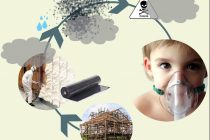The acoustical properties of a home can either make it a pleasant and peaceful place to be or a disruptive and aggravating environment. Finishes that are porous tend to absorb sound, whereas smooth shiny surfaces tend to reflect sound and cause noise interference. The level at which a person is disturbed by noise is of course subjective and will vary from individual to individual. Building Biology cites several adverse effects to noise exposure including: loss of concentration in intellectual (school) work; increase of blood pressure; release of stress hormones; contraction of blood vessels (stenosis); decreased digestion due to negative impact on peristalsis; ulcers. And of course, another adverse effect of noise is hearing loss. Noise-induced hearing loss is often in the frequency range of 4000 to 6000 hertz. (Reference 1)
You can download this fact sheet by clicking here.
There are various types of noise that can effect us. Noise transmission through walls within a home, noises from outside like air or street traffic and noise that is in the form of vibration,often from mechanical equipment.
Here are some Building Biology recommendations:
- When designing a home place quiet rooms such as bedrooms away from street noise.
- Wherever possible leave porous surfaces unsealed or seal with natural waxes and oils so that they still absorb sound.
- Mass walls such as straw-bale, adobe or masonry will absorb sound
- Isolate mechanical equipment from living areas and so that vibration from them does not travel through building materials.
- In conventional construction, when using specialized sound boards for wall sheathing, acoustical tiles for ceilings, or insulation within interior walls, make sure that the products used are nontoxic.
When a varnish seals all surface pores, a very smooth surface is created. As a result, the sound absorption capacity of this surface will be very low. Since sound waves are easily reflected, noise levels will be higher. This is to be avoided in indoor environments, especially where large surface areas are concerned. Mass wall materials on the interior of a home not only contribute to a more even climate, when used in the proper locations they can block airborne noise transference between rooms. Adding mass or insulation between floors can also help to prevent airborne transfer of noise between stories. To prevent vibrational transfer of noise acoustic isolation is required. One method to avoid this is by staggering studs so that there is no sound bridge in a wall or floor.
Outdoor-Indoor Transmission Class is a standard employed for rating the transmission of outdoor sound into indoor spaces. It is more heavily weighted to the lower frequencies of air, rail and road traffic. Some municipalities in the US have established day-night noise level standards in decibels which building envelopes must withstand. Window and door openings are weak points in a structure with regards to sound transmission from air and ground traffic. Several things can be done to lessen this sound transmission. These include careful detailing and good insulation around the window framing and increasing the layers and quality of the glass.
From a Building Biology point of view, a window’s major purpose is to open and let in fresh air! Making the windows more sound proof, in conjunction with mechanical air filtration/ventilation can improve living conditions where street noise exists at unacceptable levels. Homes can be designed with quiet central courtyards and planned with quiet rooms such as bedrooms facing the courtyards and having ample operable windows. The building itself can act as a sound buffer for the quiet interior courtyard. Utility rooms and more active rooms such as kitchens can be placed on the traffic side of the building, with minimal glazing. However these measures do not replace good municipal planning which includes separation of major thoroughfares from dwellings and employing planted, bermed green zones between the two.
Insulation will noticeably reduce airborne noise and improve the STC (Sound Transmission Class) rating of exterior walls. Staggered or double stud walls achieve higher ratings than single stud walls. Metal stud walls perform better than wood stud walls although they are not desirable from a Building Biology standpoint. Putting surfacing board on resilient channel can improve the STC rating of an assembly, as can adding additional layers of drywall. Solid masonry walls that are thicker than 6” will also achieve acceptible STC levels. From a building biology point of view these are a very attractive solutions since the walls will also add thermal mass for climate control.
In North America, acoustic tiles are commonly used for commercial buildings and schools, and are sometimes used in residential construction. They are designed to reduce noise and hide services above the ceiling in dropped ceiling designs (wiring, duct work). Cellulose fibers with a facing of Kraft paper are the most common material used for ceiling tiles. Sometimes gypsum is used so these would have the same health issues as drywall (or sheet rock). Health problems are mostly dust related and mainly affect the worker, as the small fibers splinter off at the edge of each panel. However, this problem is aggravated because the dust from the “industrial gypsum” may contain a substantial amount of toxic pollutants, such as heavy metals, and a large variety of petrochemicals which have been captured in the industrial cleaning process. It is also possible that “industrial gypsum” is radioactive.
The Kraft paper used as facing for the tiles is often made from recycled newspaper and could affect sensitive people. Many old acoustic tiles contained asbestos and here lung problems ensue because the dust is very fine and very sharp. Builders should take precautions (masks) and hypersensitive people must test the entire system (drywall, Kraft paper, joint compound, and wall cover). Furthermore, the mining of gypsum has a negative environmental impact, and disposing large amounts of toxic industrial gypsum is a big problem too.
Want to learn more on this issue? Click the comprehensive online course, here below.
References:
(Reference 1) Sensory System. Biology Articles, Tutorials & Dictionary Online.


